NCERT Class 12 History MCQ Chapter 3 Kinship, Caste and Class Early Societies Solutions to each chapter is provided in the list so that you can easily browse through different chapters NCERT Class 12 History MCQ Chapter 3 Kinship, Caste and Class Early Societies and select need one. NCERT Class 12 History MCQ Chapter 3 Kinship, Caste and Class Early Societies Question Answers Download PDF. NCERT History MCQ Class 12 Solutions.
NCERT Class 12 History MCQ Chapter 3 Kinship, Caste and Class Early Societies
Also, you can read the NCERT book online in these sections Solutions by Expert Teachers as per Central Board of Secondary Education (CBSE) Book guidelines. CBSE Class 12 History MCQ Solutions are part of All Subject Solutions. Here we have given NCERT Class 12 History MCQ Part – I: Themes in Indian History, History MCQ Part – II: Themes in Indian History, History MCQ Part – III: Themes in Indian History. NCERT Class 12 History MCQ Chapter 3 Kinship, Caste and Class Early Societies Notes, NCERT Class 12 History MCQ Notes for All Chapters, You can practice these here.
Kinship, Caste and Class Early Societies
Chapter: 3
| THEMES IN INDIAN HISTORY (PART – I) |
| MCQ |
1. The name of epic of ancient India is:
(a) Mahabharata.
(b) Rigveda.
(c) Manusmriti.
(d) None of above books.
Ans: (a) Mahabharata.
2. The total number is verses n Mahabharata:
(a) 1,00,000.
(b) 1,0000.
(c) 10,00000.
(d) 1000.
Ans: (a) 1,00,000.
3. One of the ambitious projects of scholarship to begin a critical edition of Mahabharat in year:
(a) 1919 A.D.
(b) 1818 A.D.
(c) 1717 A.D.
(d) 1616 A.D.
Ans: (a) 1919 A.D.
4. V.S. Sukthankar was a great scholar of:
(a) English.
(b) French.
(c) Tamil.
(d) Sanskrit.
Ans: (d) Sanskrit.
5. The word ‘Kula’ is used in Sanskrit test for:
(a) For family.
(b) For king.
(c) For caste.
(d) None.
Ans: (a) For family.
6. Smriti are related with:
(a) Hindu religious text.
(b) The Buddhist religious text.
(c) The Jain religious text.
(d) Islamic religious text.
Ans: a) Hindu religious text.
7. Out of the following which two are the most popular:
(a) Manusmmt and Yajhavalkya samriti.
(b) Narad Smiriti and Prghar smiriti.
(c) Param Ram Smriti and Hanuman smiriti.
(d) Shaya smiriti and Vishnu Smiriti.
Ans: (a) Manusmmt and Yajhavalkya samriti.
8. In which text a daughter is the source of all sorrow?
(a) Manusmriti.
(b) Aitereya Brahman.
(c) Maitrayani Samhita.
(d) Atharva Veda.
Ans: (b) Aitereya Brahman.
9. In Mahabharat, Kaurav and Pandavas were from which dynasty?
(a) Ichavaku.
(b) None of the abo.
(c) Kuru.
(d) Vats.
Ans: (c) Kuru.
10. To marry your daughter outside the gotra is known as?
(a) Exogamy.
(b) Same marriage.
(c) opposite marriage.
(d) Intermarriage.
Ans: (a) Exogamy.
11. The people who touched the funeral and dead animals were known as:
(a) Untochables.
(b) Chandals.
(c) Shudra.
(d) Chamaar.
Ans: (b) Chandals.
12. What was the name of the Chinese Buddhist Missionary who came in th 5th century:
(a) Hiuen Tsang.
(b) Itisangh.
(c) Fa-Hien.
(d) Ibn Barruta.
Ans: (c) Fa-Hien.
13. Name the Pilgrim who came from China in the 7th century:
(a) Xuan Zang.
(b) Both (a) and.
(c) ltsangh.
(d) None of the above.
Ans: (a) Xuan Zang.
14. Mahabharat has a very descriptive depiction of:
(a) Battle.
(6) Palaces.
(c) Villages.
(d) All of the above.
Ans: (d) All of the above.
15. He excavated the Meerut District in 1951-52:
(a) B.B.Vats.
(b) B.B.LAL.
(c) James Princep.
(d) R. Das Banerjee.
Ans: (b) B.B.LAL.

Hi! my Name is Parimal Roy. I have completed my Bachelor’s degree in Philosophy (B.A.) from Silapathar General College. Currently, I am working as an HR Manager at Dev Library. It is a website that provides study materials for students from Class 3 to 12, including SCERT and NCERT notes. It also offers resources for BA, B.Com, B.Sc, and Computer Science, along with postgraduate notes. Besides study materials, the website has novels, eBooks, health and finance articles, biographies, quotes, and more.




